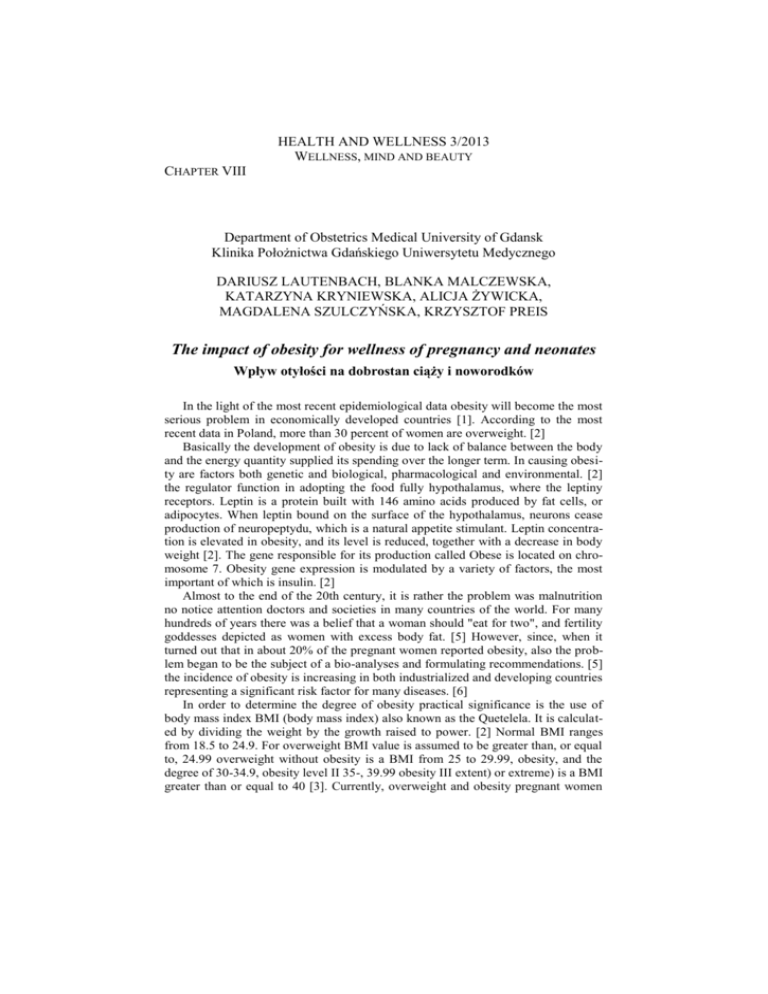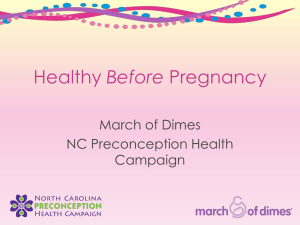Results - NeuroCentrum
advertisement

HEALTH AND WELLNESS 3/2013 WELLNESS, MIND AND BEAUTY CHAPTER VIII Department of Obstetrics Medical University of Gdansk Klinika Położnictwa Gdańskiego Uniwersytetu Medycznego DARIUSZ LAUTENBACH, BLANKA MALCZEWSKA, KATARZYNA KRYNIEWSKA, ALICJA ŻYWICKA, MAGDALENA SZULCZYŃSKA, KRZYSZTOF PREIS The impact of obesity for wellness of pregnancy and neonates Wpływ otyłości na dobrostan ciąży i noworodków In the light of the most recent epidemiological data obesity will become the most serious problem in economically developed countries [1]. According to the most recent data in Poland, more than 30 percent of women are overweight. [2] Basically the development of obesity is due to lack of balance between the body and the energy quantity supplied its spending over the longer term. In causing obesity are factors both genetic and biological, pharmacological and environmental. [2] the regulator function in adopting the food fully hypothalamus, where the leptiny receptors. Leptin is a protein built with 146 amino acids produced by fat cells, or adipocytes. When leptin bound on the surface of the hypothalamus, neurons cease production of neuropeptydu, which is a natural appetite stimulant. Leptin concentration is elevated in obesity, and its level is reduced, together with a decrease in body weight [2]. The gene responsible for its production called Obese is located on chromosome 7. Obesity gene expression is modulated by a variety of factors, the most important of which is insulin. [2] Almost to the end of the 20th century, it is rather the problem was malnutrition no notice attention doctors and societies in many countries of the world. For many hundreds of years there was a belief that a woman should "eat for two", and fertility goddesses depicted as women with excess body fat. [5] However, since, when it turned out that in about 20% of the pregnant women reported obesity, also the problem began to be the subject of a bio-analyses and formulating recommendations. [5] the incidence of obesity is increasing in both industrialized and developing countries representing a significant risk factor for many diseases. [6] In order to determine the degree of obesity practical significance is the use of body mass index BMI (body mass index) also known as the Quetelela. It is calculated by dividing the weight by the growth raised to power. [2] Normal BMI ranges from 18.5 to 24.9. For overweight BMI value is assumed to be greater than, or equal to, 24.99 overweight without obesity is a BMI from 25 to 29.99, obesity, and the degree of 30-34.9, obesity level II 35-, 39.99 obesity III extent) or extreme) is a BMI greater than or equal to 40 [3]. Currently, overweight and obesity pregnant women HEALTH AND WELLNESS 3/2013 Wellness,mind and beauty are one of the most important problems, increasing obstetric risk of maternal complications and fetal [7]. Normal weight gain during pregnancy should be 11-12 kg [8]. Multicenter studies and Polish scientific studies have confirmed that excessive increase in weight gain in pregnant women is accompanied by an increase in the average birth weight of newborn and an increased incidence of makrosomie, and the risk of an intrauterine fetal death is three times higher than in women with normal BMI index [4]. In addition, it has been proven that the infants of obese mothers are born in worse condition, receive a lower score Apgar and often come with birth. Also with a high BMI index patients puerperium is more complex a slow healing wounds, inflammation of mammary gland, or anemia. Sutter and SP. also noted that obese patients ' hospitalization time is longer than women with normal body weight and also occurs in them greater blood loss during delivery by caesarean section. In summary, pregnancy and childbirth in women who are overweight requires special monitoring. An increased risk of complications should lead obstetricians to increased vigilance and intensive care [4]. The purpose of this work is to determine the role of before - pregnant weight in predicting newborn birth weight, risk of gestational diabetes, pregnancy induced hypertension and the completion of pregnancy by caesarean section. MATERIAL AND METHOD The analysis included 40 women with overweight and 43 pregnant with normal BMI giving birth at the clinic of obstetrics of the Medical University of Gdańsk in the period from October 2013 and April 2013. Analysis of data was carried out on the basis of surveys and medical records of patients. From the study excluded women who during the period of before pregnant disease have occurred that may affect the pregnancy (diabetes, hypertension, neurological diseases, heart disease and kidney disease. In relation to the data obtained, adopted a significance level p = 0,05. Critical values are read from the array t-Student distribution. RESULTS Table 1. Examined group (I) Age 29,22 ± 4,26 Height 167,67 ± 5,19 Weight 81,61 ± 16,11 BMI before pregnancy 28,80 ± 5,08 Weight gain during pregnancy 14,82 ± 5,88 Control group (II) 30,60 ± 3,53 167,90 ± 5,58 60,17 ± 5,39 21,26 ± 1,64 19,39 ± 4,34 Statistical significance No p > 0,05 No p > 0,05 No p < 0,05 No p < 0,05 No p > 0,05 In both groups, as shown in Table 1, both age and height were similar and not statistically significant (p> .05). In the group of patients with excessive weight average weight was 81.61 kg. While BMI - 28.8. The results that were obtained in the 92 Dariusz Lautenbach, Blanka Malczewska, Katarzyna Kryniewska, Alicja Żywicka, Magdalena Szulczyńska, Krzysztof Preis The impact of obesity for wellness of pregnancy and neonates control group, respectively 21.6 and 60.17 kg. There was a similar weight gain during pregnancy in both groups. In the group of women, obesity amounted to 14.82 kg and was 0.57 kg. lower than in group II, which did not provide statistical significance. Among women with normal body weight from baseline 34.6% exhibited excessive weight gain during pregnancy, on average 19.67 kg. While overweight women with excessive weight gain occurred in 71% of patients, an average of 17.05 kg. 22.2% of patients in group I had difficulty getting pregnant and used the techniques of assisted reproduction, while in Group I of this issue did not relate to a single patient. The average duration of pregnancy in patients in group I was 39.72 ± 1.33 weeks, while in group II 38.89 ± 2.13 weeks the difference was not statistically significant. Table 2 presents the most common pregnancy complications in both groups. Table 2. PIH Study Control Statistical group (I) group (II) significance yes p < 0,05 24,00% 0,00% PROM 29,00% Gestational hypothyroidism 24,00% Amaemia 5,88% Intrahepatic cholestasis of pregnancy 6,00% 7,00% yes p < 0,05 17,90% no p > 0,05 25,00% no p > 0,05 3,60% no p > 0,05 In the study group draws attention quite a number of cases of pregnancy induced hypertension, premature rupture of membranes, gestational hypothyroidism and cholestasis and low in comparison with the control group the incidence of anemia. Not one of the patients did not have gestational diabetes. Statistical significance at p <0.05 was found, however, only in pregnancy-induced hypertension and premature rupture of membranes. In other cases, despite the numerical differences were not statistically significant. Mode of delivery is a graph of the first In pregnant women with abnormal body weight before pregnancy, cesarean sections accounted for as much as 70%, whereas in the control group 30%, which is statistically significant at p <0.05. Other obstetric procedures both in group I and II were carried out in either one case. During surgery, cesarean section in pregnant women in the study group had a larger blood loss - an average of 420.63 ± 102.99 ml, while women in the control group was 351.92 ± 147.30 ml., but the difference was not statistically significant. In any group there was no need for red blood cell transfusions. The duration of cesarean delivery was longer in women who are overweight and was 48.75 ± 7.9 min., whereas in women with normal body mass operation lasted an average of 37.5 ± 7.5 min., which was statistically significant at p < 0.05. Postoperative complications such as dehiscence and wound infection occurred in 11.7% of cases only among patients in the study group. In all patients anesthesia was 93 HEALTH AND WELLNESS 3/2013 Wellness,mind and beauty selected regional anesthesia. In one, there were no abnormal cardio - pulmonary system. Hospitalization time in both groups was similar and amounted to 5.88 for group I day, and for group II 5.5 days, which did not provide statistical significance. The average weight infants in the study group was higher and amounted to 3592.94 ± 730.64g, whereas in the control group 3424 ± 533g., It was not a statistical significance. Scoring the Apgar score and the length of the children's bodies are not statistical differences. Data on neonatal provided show Table 3. Figure 1. Table 3. Study Control group (I) group (II) Neonate body mass 3592,94 ± 730,64 g. 3424,20 ± 533,40 g. Neonate body length 54,8 ± 3,91 cm. 54,04 ± 2,47 cm. Apgar score 8,83 ± 1,19 9,29 ± 1,27 Statistical significance No p > 0,05 No p > 0,05 No p > 0,05 DISCUSSION Excessive weight gain in pregnancy is a serious problem obstetrics. Pregnancy and childbirth in women who are overweight or obese is associated with an increased risk of complications, both for the mother and the neonates. [4] The tenden94 Dariusz Lautenbach, Blanka Malczewska, Katarzyna Kryniewska, Alicja Żywicka, Magdalena Szulczyńska, Krzysztof Preis The impact of obesity for wellness of pregnancy and neonates cy of society to gain weight deepens with each passing year. Based on data obtained from representative surveys conducted throughout the country, excessive body weight were observed in approximately 50% of adult women, of which 28 - 29% were overweight and 19 - 22% diagnosed with obesity [16]. Patients in the study group will therefore be more likely to show up in doctors' offices and a growing challenge for obstetricians. According Krasnodębski et al [2] pregnant overweight are older than the maternity of normal weight. Our research has not however confirmed that the trend in both groups received verisimilar results. Since the method and eating habits and weight gain depends on the degree of rate and extent of weight gain during pregnancy, which can intensify obesity [9]. There is no doubt that weight gain during pregnancy in women with overweight and obesity should be lower than in women with normal body weight, respectively, 7 11.5 kg (overweight), and 5 - 9 kg (obesity) [16]. The results led the authors of the study showed that 34.6% of women at baseline normal BMI result, increased their weight than the standards recommended by WHO and ACOG [4], and in women with a BMI over 25 the figure was up 71%. Patients in both groups at the same time characterized by a similar average body weight gain during pregnancy. Excess energy reserves in the body leads to a variety of pathophysiological changes in a pregnant woman's body. It is known that any increase in the adipose tissue of 100 g in the body of the pregnant woman should be associated with increased stroke volume (about 30 - 50 ml.). Functional overload left ventricular hypertrophy and causes it to "stretch" the myocardial infarction [10]. This results in a significant increase in heart rate and the secondary overload, which may result in chest pain and in combination with reduced susceptibility to chest breathing effort significantly reduced exercise tolerance, and shortness of breath. Were published research on the effects of obesity on the ability to have children and has been shown to limit the negative impact of physical activity on human procreation [19,20]. Fat girls in adolescence significantly reduces their chances of getting pregnant and having children at a later age [10]. Our study showed that 22.2% of women had used assisted reproductive techniques. It should also be emphasized that obesity in women is associated not only with a decrease in natural fertility, but also reduces the effectiveness of assisted reproduction procedures. [10] Obesity is the cause of pregnancy prevalence of hypertension in pregnancy [2]. Hypertension is diagnosed when systolic exceeds 140/90 mm Hg [11]. A prerequisite for the diagnosis of gestational hypertension is to occur after the completion of 20 weeks of pregnancy. In our study, this ailment complicated 24.00% of pregnancies in patients with excess body weight, which corresponds to a given that you can find in other authors. Biochemical disorders in obese women leads to a higher incidence of pre-eclampsia and eclampsia [2]. These conditions may be caused by increased concentration of triglyceride-rich lipoproteins, which directly or indirectly affect the function of vascular endothelium causing damage [12]. In our study, the occurrence was significantly more frequent in women who are overweight premature rupture of membranes (PROM). PROM is defined as a viola95 HEALTH AND WELLNESS 3/2013 Wellness,mind and beauty tion of the integrity of the fetal membranes and amniotic sac emptying, manifested flotation cervical amniotic fluid. Physiologically, the rupture of the membranes occurs in time of birth - during the systolic or hours before the start of regular contractile function [13]. Inconsistent data on the duration of pregnancy [2] in women with abnormal body weight. In our study, we did not identify the differences between the duration of pregnancy in patients with a normal BMI, and in the study group. Similar conclusions in his work presented Krasnodębski et al whereas other authors suggest a tendency to prolong the pregnancy over 42 weeks [17]. Overweight pregnant women is associated with double the risk of caesarean section compared to patients with a standard BMI. For the latter, the risk is greater than three times [4]. In our study, 70% of pregnancies in women with obesity surgery have been solved, while in the control group, the rate was 30%. It should be noted, however, that the exclusion from the study group of women with pregnancy-induced hypertension and threatening rupture of the uterus, which were also the most common indications for cesarean delivery performance Births operating in both groups was comparable. In all cases a transverse suprapubic incision. Obese pregnant belong to an increased risk of anesthesia [14, 8]. Lung volume obese patients is reduced. Some parts of the lungs are ventilated worse in comparison to the others. Also, obese heart patients must do more work to pump sufficient amount of blood. If the blood that flows through the coronary heart does not meet demand, it can lead to postoperative myocardial infarction [14]. In our analysis, all the women were anesthetized using spinal anesthesia, which according to researchers is a safer method for these patients. In obese women undergoing extraction of the fetus is extended, the operation takes longer and results in greater blood loss [14]. Our analysis only partially confirms this thesis. Caesarean section took significantly longer in women with abnormal BMI (48.75 min) than in women with normal weight (37.5 min). There were no greater intraoperative blood loss in patients in the study group. Impaired wound together with dispersing the abdominal wall at the surgical cut is one of postoperative complications [15] occurring in about 10% of the cases [18]. In our study, the complication occurred in 11.7% of obese patients, while women lean not recorded a single such case. The results obtained in this study do not support the belief that overweight pregnant were hospitalized longer than patients in the control group. This is probably due to the fact prolong hospitalization frequent phenomenon in women with normal BMI even the fact the implementation of detailed studies on the health of the neonates. When analyzing the average birth weight and Apgar scores did not notice any significant statistical differences with the control group, which is consistent with the observations of the authors who believe that if obese women is not aware of any other irregularities outside of excess body weight, infants are not at high risk [9, 5]. In our study, the difference in birth weight infants between the study group and the control group was 168.74 g Krasnodębski et al pointed out, however, that infants are 96 Dariusz Lautenbach, Blanka Malczewska, Katarzyna Kryniewska, Alicja Żywicka, Magdalena Szulczyńska, Krzysztof Preis The impact of obesity for wellness of pregnancy and neonates reported in obese women were about 300 grams heavier. [2] There is so conclusive data proving that being overweight was supposedly affect the high mass of children. Fetal macrosmia is defined according to the criteria adopted as a birth weight above 4000, 4200, 4500 g or fetal weight exceeding the 90th percentile for gestational age, sex and ethnicity [17]. Taking the most popular among obstetricians as a criterion macrosomia offspring weight above 4000 g, we have received in our study group 29.4% of the children in the group of macrosomic obese. In women with normal body weight percentage was 10%. Current knowledge about overweight and obesity during pregnancy still does not give answers to many questions. Although aware of the risks caused by excessive BMI is increasing, and high body mass is a condition substantially limiting physical activity and very unpleasant in many areas of life does not translate into a decrease in obesity in the population of pregnant women. Currently available literature does not answer how to effectively fight excessive weight gain during pregnancy in women who are overweight. The method of choice is currently restricting food intake and increased physical activity. It should be emphasized also the fact that the pregnant women with excessive body weight is also difficult from an economical point of view, these patients because they require frequent hospitalizations compared to the general population. CONCLUSION 1. Women with excess body weight are significantly more difficulty becoming pregnant. 2. In pregnant women with abnormal pregnancy BMI is often complicated by pregnancy induced hypertension. 3. Pregnancy far more common in these patients is reversed by cesarean section. 4. Operating birth in women with overweight and obesity takes longer and is saddled with more complications. REFERENCES 1. Szostak, Magdalena Białkowska: Otyłość problem o rosnącym znaczeniu w podstawowej opiece zdrowotnej. Przewodnik Lekarza s. 36. 2. Krasnodębski Janusz, Zemanek – Wojnowska Agnieszka,Krysta Anna: Ciąża i poród u pacjentki otyłej. Ginekologia praktyczna s. 15 3. Trąbska – Berner M, arlena, Kowalska – Koprek Urszula ,Karowicz – Bilińska Agata , Brzozowska Maria, Estemberg Dorota, Orłowska Katarzyna, Kuś Ewa: Wpływ nadwagi lub otyłości u ciężarnych na przebieg ciąży i okresu okołoporodowego z uwzględnieniem stanu urodzeniowego noworodka w oparciu o materiał kliniczny. Ginekologia Polska 2009, 80 97 HEALTH AND WELLNESS 3/2013 Wellness,mind and beauty 4. Ulman – Włodarz Izabela, Nowosielski Krzysztof, Romanik Małgorzata, Pozowski Janusz, Krawczyk Patrycja : Przebieg ciąży i porodu u ciężarnych z nadmierną masą ciała, Ginekologia Polska 10/2009 5. Wdowiak Artur, Kandys Katarzyna, Lewicka Magdalena, Bakalczuk Grzegorz, Bąk Magdalena: Przyrost masy ciała w ciąży a wybrane elementy oceny stanu noworodka, Problemy higieniczno – epidemiologiczne 2011, s. 281 - 285 6. Bebelska Karolina Paulina, Ehmke vel Emczyńska Ewa, Gmoch Gajzelska Ewa: Otyłość jako czynnik zaburzający procesy rozrodcze, Nowiny Lekarskie 2011, s. 499 – 507 7. Przybyłowicz Katarzyna Eufemia, Janiszewska Katarzyna, Przybyłowicz Mariusz, Grzybiak Marek: Zależność między matczynymi BMI kobiet, spożyciem błonnika i tłuszczu w czasie ciąży, a masą urodzeniową noworodka, Bromatologia, Chemia, Toksykologia XLV, 2012, 3 s. 1010 0 1017 8. Skowrońska Jóźwiak Elżbieta: Otyłość a ciąża w praktyce lekarza endokrynologa, Perinatologia, Neonatologia i Ginekologia tom 2, zeszyt 8 s. 215 – 217 2009 9. Trąbska Berner Marlena, Kowalska Koprek Urszula, Karowicz Bilińska Agata, Brzozowska Maria, Estemberg Dorota, Orłowska Katarzyna: Wpływ nadwagi lub otyłości u ciężarnych na przebieg ciąży i okresu okołoporodowego z uwzględnieniem stanu urodzeniowego noworodka w oparciu o materiał kliniczny, Ginekologia Polska 2009,80, 845 – 850. 10. Medard Lech M.: Otyłość a ciąża, poród i stan zdrowia w późniejszym okresie życia kobiety 11. Bręborowicz Grzegorz H.: Położnictwo i Ginekologia, Wydawnictwo Lekarskie PZWL 2007, s. 194-195. 12. Sattar N., Gaw A., Potential pathogenic roles of aberrant lipoprotein and acid metabolism in preeclampsia, Br J obstet Gyneacol. 1996, 103, 614. 13. Piec Przemysław, Suchocki Sławomir, Obst Michał: Przedwczesne pęknięcie błon płodowych u ciężarnych w 22 – 37 tygodniu ciąży w latach 2001 – 2005 w materiale Specjalistycznego Szpitala Ginekologiczno – Położniczego w Wałbrzychu, Parinatologia, Neonatologia i Ginekologia, tom 1, zeszyt 2, 121 – 126, 2008 14. Krasnodęski Janusz , Krysta Anna, Baliś Michał: Cięcie cesarskie u cięzarnej z nadwagą, Ginekologia Praktyczna s. 31 – 35 15. Smolarek Natalia, Pisarska Krawczyk Magdalena, Kampioni Małgorzata, Sajdak Stefan: Rehabilitacja otyłych pacjentek po operacjach ginekologicznych, Ginekologia praktyczna, s. 13 – 16 16. Gutaj Paweł, Wender Ożegowska Ewa, Mantaj Urszula, Zawiejska Agnieszka, Brązert Jacek: Matczyny BMI oraz przyrost masy ciała w ciąży i ich wpływ na wyniki położnicze u kobiet z cukrzycą ciążową, Ginekologia Polska s. 827 – 833 98 Dariusz Lautenbach, Blanka Malczewska, Katarzyna Kryniewska, Alicja Żywicka, Magdalena Szulczyńska, Krzysztof Preis The impact of obesity for wellness of pregnancy and neonates 17. Kandys Maciej Wiesław, Gorzelak – Leszczyńska Bożena, Oleszczuk Jan: Otyłość u kobiet. Aspekty Kliniczne otyłości podczas ciąży, Perinatologia, Neonatologia i Ginekologia, tom 2, zeszyt 4, 254 – 265, 2009 18. Dudenhausen Joachim W., Pschyrembel Wilibald: Położnictwo praktyczne i operacje położnicze, Wydawnictwo Lekarskie PZWL 2002 s.34. 19. Standardy Polskiego Towarzystwa Ginekologicznego: Opieka położnicza nad ciężarną otyłą. 20. Wieckiewicz Dorota, Ziemek Mariusz: Otyłość a problem niepłodności u kobiet, Perinatologia, Neonatologia i Ginekologia ABSTRACT Currently, overweight and obesity pregnant women are one of the most important problems, increasing obstetric risk of maternal complications and fetal. Our analysis included 40 women with overweight and 43 pregnant with normal BMI giving birth at the clinic of obstetrics of the Medical University of Gdańsk in the period from October 2013 and April 2013. Analysis shows that women with excess body weight are significantly more difficulty becoming pregnant. In pregnant women with abnormal pregnancy BMI is often complicated by pregnancy induced hypertension and they far more common have cesarean section which takes longer and is saddled with more complications than have women with normal BMI. STRESZCZENIE Obecnie nadwaga i otyłość kobiet w ciąży są jednym z najważniejszych problemów, które prowadzą do zwiększenia ryzyka wystąpienia powikłań położniczych jak i w konsekwencji gorszego stanu noworodków po porodzie. Nasza analiza obejmowała 40 kobiet z nadwagą i 43 pacjentki w ciąży z normalnym BMI, badanych po porodzie odbytym w Klinice Położnictwa Akademii Medycznej w Gdańsku, w okresie od października 2013 do kwietnia 2013 roku. Analiza wykazała, że u kobiet z nadwagą występują trudności w zajściu w ciążę. U kobiet w ciąży z nieprawidłowym BMI występuje częściej nadciśnienie indukowane ciążą oraz znacznie częściej wykonywane jest cięcie cesarskie, które trwa dłużej i jest obarczone większą liczbą powikłań, niż u kobiet z prawidłowym BMI. Artykuł zawiera 22771 znaków ze spacjami 99








